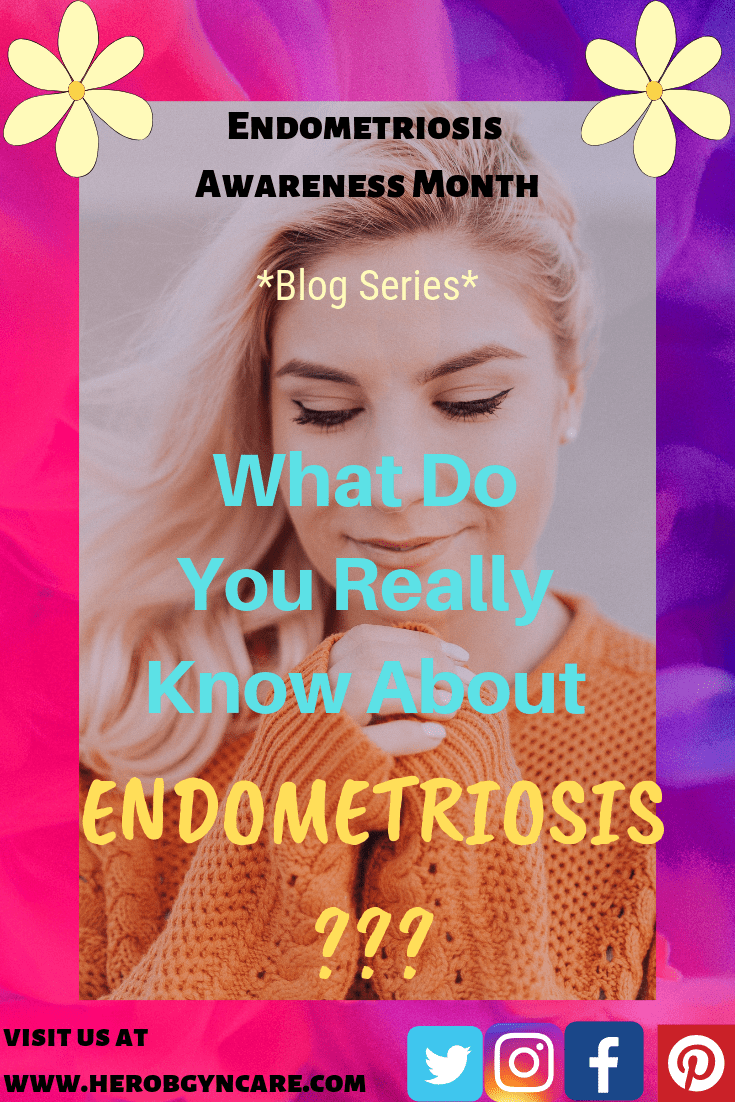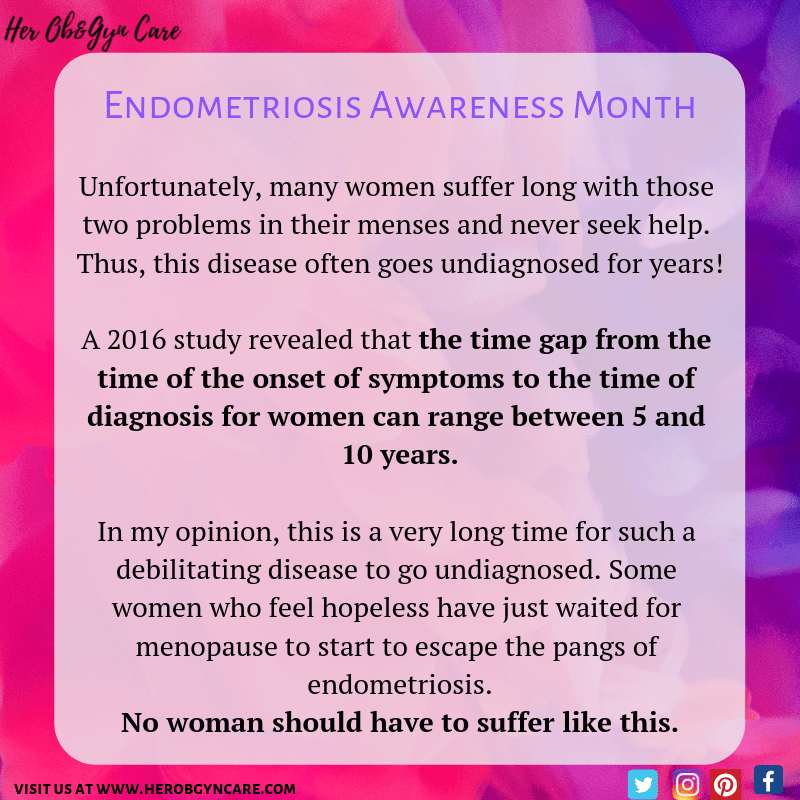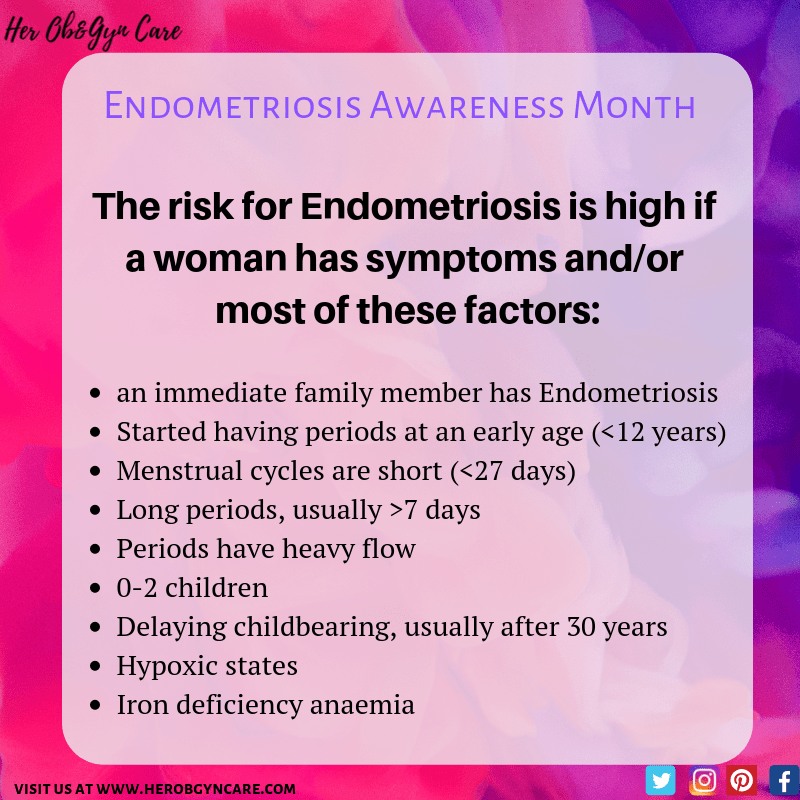Hey Lovies!
Today, I just want to tell you a bit about ENDOMETRIOSIS.
March is the celebrated month for Endometriosis. I didn’t want to miss the opportunity to get the word in to you and the many women across the world who may be suffering from this terrible disease.
Can you believe that we are in the 3rd month of the year already? Wow! Time really does fly!
Anyways, I’m glad you decided to join me one more time for another knowledge-packed session!
What is Endometriosis?
Do you remember from my previous post, Menstrual Cramps: Get through the Holidays without them…
where I told you what the period was? If not, let me quickly refresh you…
A woman’s menses is simply that period of her menstrual cycle when she sees bleeding from the vagina.
The bleeding is the result of the shedding of the lining of her uterus (womb). This lining is called the ENDOMETRIUM.
The lining of the womb will regenerate (grow back) after her menstrual bleed has stopped. Then the cycle repeats itself.
Blog post Her Ob&Gyn Care ©
One would think that this lining which is shed ought to be in the womb only, right?
Well, Endometriosis is the presence of the lining is in areas outside of the womb.
We refer to this abnormally placed lining as endometrial deposits (you should remember this term as you will be seeing it a lot throughout this post).
Abnormal Locations
So, the endometrial deposits can basically end up any and everywhere.
The most common area for endometriosis is the pelvis. It can get deposited in the organs of the pelvis also including
- the ovaries (30-40%)
- the supporting ligaments of the womb – you will hear your doctor mention the utero-sacral ligaments and the round ligaments.
- Vagina
- Bladder
- Rectum
Outside of the pelvis, the endometrial tissue can be found at
- the umbilicus (belly button area),
- scars in the abdomen (like the scar from a C-section, appendix removal, etc.)
- nasal passages
- pleural cavity (lining of the lungs)
- peritoneal cavity (inside the abdomen)
- the bowel
- brain
How common is Endometriosis?
It affects up to 2% of women. It strikes only during reproductive years, commonly ages 12 to 64 years. The peak age group affected are women 25 to 30 years old.
This is because it thrives on the presence of oestrogen, produced throughout the menstrual cycle. However, once menopause arrives, it is gone for good.
Kudos to those menopausal women out there!
It’s also important to note that 20-50% women who are infertile also have Endometriosis. Over 40% of women who suffer from subfertility are found to have Endometriosis too.
It is also responsible for over 80% cases of chronic pelvic pain (CPP).
Too Long
Endometriosis is a common cause of severely painful menses. It is also responsible for some cases of heavy menses.
You should never take on that mindset.
There are many doctors out there who are willing to help, and I am one of them.
So, let me take the time to educate you.
What increases the chances of Endometriosis?
Researchers still rely on theories today to explain how this disease occurs. There are 4 dominant theories out there. All are plausible, and they can explain how some manifestations of the disease occur.
However, we are still conducting further research to identify all the possible factors at work which makes this disease so vicious and to help us create better treatment options for women and hopefully prevention.
In the meantime, there are some risk factors that we must be aware of. These should not be overlooked especially in a situation of strong family history.
Effects of Endometriosis
Due to the nature of the endometrial deposits, the symptoms of Endometriosis manifest mainly during the menses. However, as time progresses, other ‘non-menstrual’ symptoms will arise.
Endometrial deposits respond in the same way that the lining of the womb responds to the different sex hormones – Oestrogen and progesterone throughout the menstrual cycle.
Therefore, they grow, thicken and bleed during the period, just like in the womb.
As with any tissue, after bleeding comes healing.
The more these deposits bleed, the more they will heal and lead to FIBROSIS.
This is the worst part of the disease!
When the fibrosis occurs in those abnormal locations, problems arise. I will tell you more about it later.
These endometrial deposits kick-start the inflammatory cascade similar to normal tissue. This leads to the release of Prostaglandins. This makes Endometriosis a disease of painful periods.
Abnormal Bleeding
The menstrual flow is the first to be affected. The flow tends to be become irregular. Then, depending on the location of the endometrial deposits, bleeding will manifest differently.
Some women will experience
- Haematuria (blood in the urine)
- Haematochezia (blood in the stool)
- Epistaxis (nose bleeding)
- Haemoptysis (coughing up blood)
Other Symptoms
The bleeding associated with Endometriosis is just the tip of the iceberg.
This disease manifests in a variety of ways dependent on the organ system affected. Of course, the reproductive system is the most affected. The other systems affected include:
- Urinary system
- Gastrointestinal system
- Pulmonary system
- Skin
Wrapping Up
Lovies, this is all I wanted to tell you today to get your minds thinking. I have more info if you are serious about becoming aware of Endometriosis once and for all.
Join me in the next post How to Know If You Have Endometriosis to learn exactly how this debilitating disease can affect a woman’s sex life, her reproductive system and all the other systems in the body. You don’t want to miss out on that important session.
It’s the meat of the matter. So, CLICK THE LINK! 👆👆👆
If you liked this post, you can leave a comment below to let me know your thoughts. You should consider sharing with your friends too. I am sure they will be enlightened.
You should follow us on social media where we share other info on Endometriosis and other important topics about sex and fertility
Instagram: Wannabe_futureObgyn
Facebook: Her Ob&Gyn Care
Facebook Group : Lovies Tribe of Her Ob&Gyn Care
Pinterest: Her Ob&Gyn Care*
All the best, lovies!
Have an endometriosis-awareness week!
XOXO
Creator, Her Ob&Gyn Care©
References
Morassutto, C., Monasta, L., Ricci, G., Barbone, F., & Ronfani, L. (2016). Incidence and Estimated Prevalence of Endometriosis and Adenomyosis in Northeast Italy: A Data Linkage Study. PloS one, 11(4), e0154227. doi:10.1371/journal.pone.0154227
Willy Davila, G., MD, Kapoor, D., MD, MBBS, MRCOG, Alderman, E., MD, Hiraoka, M. K., MD, Ghoniem, G., MD, FACS, Peskin, B., MD, MBA, & Price, T. M., MD. (2018, July 27). Endometriosis (M. Rivlin MD, F. Casey MD, MPH, & F. Talavera PharmD, PhD, Eds.). Retrieved March 6, 2019, from https://emedicine.medscape.com/article/271899-overview.





